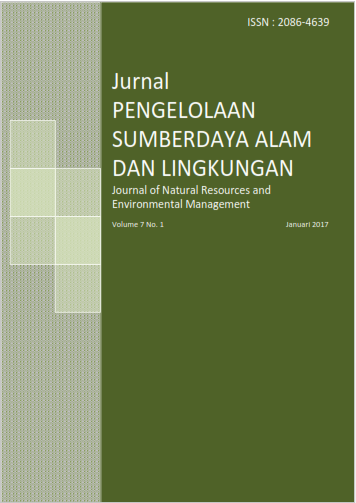Economic valuation for water supply from Merapi Volcano National Park Case study: Kali Kuning sub watershed
Abstract
The Merapi Volcano National Park (MVNP) is developed based on particular considerations such as protecting ecosystem or preserving certain species. Management of national park will not succeed unless the communities surrounding park support the park itself. However, it will be challenging because the park was established through a ‘top-down’ process. Therefore, it is important to ensure that the surrounding communities are able to derive benefit economically from the park, especially environmental services such as water supply. The goal of this study is to estimate the economic value for water supply from MVNP with Kali Kuning Sub Watershed as the study case. The economic valuation is estimated based on three different land use maps: 2015’s (deforestation), 2025’s (afforestation) and extreme condition which is grassland (without national park). The economic value is approached by market price for water use value. Lastly, cost and benefit analysis based on several scenarios (deforestation, afforestation and ‘without national park’) is implemented. The study shows that afforestation scenario presents the highest economic value from water supply for the surrounding communities as well as the downstream communities.
References
[2] Bingham, G., R. Bishop, M. Brody, D. Bromley, E. T. Clark, W. Cooper, et al., 1995. Issues in ecosystem valuation: improving information for decision making. Ecological Economics 14, pp. 73-90.
[3] Beukering, P. J. H. V., H. S. Cesar, and M. A. Janssen, 2003. Economic valuation of the Leuser National Park on Sumatra, Indonesia. Ecological Economics 44, pp. 43-62.
[4] Boyd, J., and L. Wainger, 2003. Measuring Ecosystem Service Benefits: The Use of Landscape Analysis to Evaluate Environmental Trades and Compensation. Resources for the Future, Washington.
[5] Costanza, R., R. d'Arge, R. D. Groot, S. Farber, M. Grasso, B. Hannon, et al., 1997. The value of the world's ecosystem services and natural capital. Nature 387, pp. 253-260.
[6] Gumidonga, W., T. Rientjes, A. Haile, T. Dube, 2014. Predicting streamflow for land cover changes in the Upper Gilgel Abay River Basin, Ethiopia: A TOPMODEL based approach. Physics and Chemistry of the Earth 76-78, pp. 3-15.
[7] Havid, E. and D. S. A. Suroso, 2013. Valuation of Water Production and Erosion Protection in Upstream of Tuntang Watershed for Payment of Ecosystem Services (In Bahasa). Jurnal Perencanaan Wilayah dan Kota 3 (1), pp. 46-54.
[8] Lele, S., 2009. Watershed services of tropical forest: from hydrology to economic valuation to integrated anaylisis. Environmental Sustainablity I, pp. 148-155.
[9] MacKinnon, J., MacKinnon, K., Child, G., and Thorsell, J., 1986. Pengelolaan Kawasan yang Dilindungi di Daerah Tropika (Tropical Protected Areas Management). Gadjah Mada University, Yogyakarta.
[10] Midora, L. and D. Anggraeni, 2006. Economic Valuation of Watershed Services Batang Gadis National Park, Mandailing Natal, North Sumatra, Indonesia. Conserva-tion International – Indonesia, Jakarta.
[11] Mulongoy, K. and S. Gidda, 2008. The Value of Nature: Ecological, Economic, Cultural and Social Benefits of Protected Areas. Secretariat of the Convention on Bio-logical Diversity, Montreal.
[12] [MVNP] Merapi Volcano National Park, 2011. Report: Socio Economic of Surrounding Merapi Volcano Na-tional Park Pasca Volcano Eruption in 2010, Merapi Volcano National Park, Yogyakarta.
[13] Ojea, E., J. Martin-Ortega, A. Chiabai, 2012. Defining and classifying ecosystem services for economic valua-tion: the case of forest water services. Environmental Science and Policy 19-20, pp. 1-15.
[14] Pattanayak, S. K., 2004. Valuing Watershed Services: Concepts and Empirics from Southeast Asia. Agriculture, Ecosystem, and Environtment 104, pp. 171-184.
[15] Setiyani, A. D., 2016. Economic valuation for water services from Merapi Volcano National Park, Indonesia Case Study: Kali Kuning sub watershed. Thesis. UNESCO-IHE, Delft.
[16] Tang, L., D. Yang, H. Hu, and B. Gao, 2011. Detecting the effect of land-use change on streamflow, sediment and nutrient losses by distributed hydrological simula-tion. Journal of Hydrology 409, pp. 172-182.
[17] Wang, X. et al., 2015. Assessment of soil erosion change and its relationship with land use/cover change in China from the end of the 1980s to 2010. Catena 137, pp. 256-268.
[18] Wardani, A. E. P. And I. L. S. Purnama, 2012. Evaluasi potensi mata air untuk kebutuhan air domestik di Keca-matan Cangkringan Kabupaten Sleman pasca erupsi Merapi 2010 (Potential spring evaluation for domestic uses in Cangkringan District, Sleman Regency) In Baha-sa. Jurnal Bumi Indonesia 1(3), pp. 229-309.
[19] Yan, B., N. Fang, P. Zhang, Z. H. Shi, 2013. Impact of land use change on watershed stream flow and sediment yield: An assessment using hydrologic modelling and partial; least squares regression. Journal of Hydrology 484, pp. 26-37.
Authors
Authors who publish with this journal agree to the following terms:
- Authors retain copyright and grant the journal right of first publication with the work simultaneously licensed under a Creative Commons Attribution License that allows others to share the work with an acknowledgement of the work's authorship and initial publication in this journal.
- Authors are able to enter into separate, additional contractual arrangements for the non-exclusive distribution of the journal's published version of the work (e.g., post it to an institutional repository or publish it in a book), with an acknowledgement of its initial publication in this journal.
- Authors are permitted and encouraged to post their work online (e.g., in institutional repositories or on their website) prior to and during the submission process, as it can lead to productive exchanges, as well as earlier and greater citation of published work (See The Effect of Open Access).





